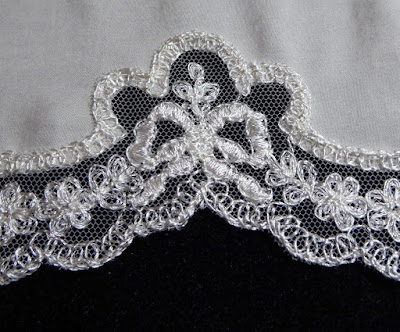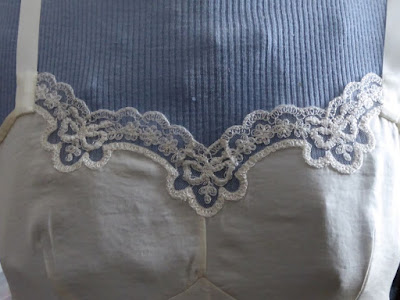A couple of months ago, I was able to indulge my love of
1979 Style patterns with a vengeance when I spotted this for sale.
 |
| Style counter catalogue, October 1980 |
Although it's from 1980, I reasoned that it would contain a lot of 1979 patterns, and it does. It's missing a number of pages at the front, but still provides some insights into home dressmaking history, and a whiff of nostalgia.
So, tackling the nostalgia-fest first. In October 1980 I was 16, and in 5th year at school (which in Scotland is the penultimate year of secondary school). We didn't have to wear uniform any longer, but were expected to 'dress smartly'. This was also when I really started making my own clothes. I don't recall making many dresses at the time; I made mostly separates as these were more useful for school.
I used this skirt pattern so often that the tissue fell apart at the tailor tack points!
 |
| 3058, from 1980 |
This was such a favourite pattern that it survived various culls over the years. I never made the tie-neck version, but am tempted to give it a go sometime.
 |
| 3095, from 1980 |
Clearly Style had a template for blouse pattern envelope illustrations! I owned and used both of these.
 |
| 2580 from 1979, and 2408 from 1978 |
Finally, I also made this nightdress (the long-sleeved version, in cotton) at some point.
 |
| 2533, from 1978. So. Much. Ironing. |
The catalogue index lists 731 patterns in total. The earliest pattern in catalogue is 3734, which is from 1972 and is for a
"nightdress and housecoat".
 |
| Eight year old pattern |
The next-oldest patterns are for stuffed toys, items for babies and young children, dressing gowns, and smocked cushions. I was amazed that this last one was still available in 1980, as I tend to associate such cushions with the 1950s/60s. It would probably be popular now for retro decor!
 |
| 4647, from 1974 |
These patterns are all for items which will not date quickly. The oldest patterns for clothes which are subject to fashion trends are these two.
 |
| 4798 and 4909, both from 1974 |
Few of the patterns are quite that old, but nonetheless it's interesting to look through the catalogue and realize just what a transitional period this was. The photographs at the start of each tabbed section are very much of their time, as are many of the designs.
 |
| Hellooooooo, 1980s! |
 |
| 2936, from 1980 - it could not be from any other decade |
But there are also patterns from just a couple of years before which, to me at least, have a very different, very 1970s aesthetic.
 |
| 2520 and 2488, both from 1978 |
 |
| 2087 from 1977, and 2440 from 1978 |
Sometimes the two decades exist side by side on a double-page spread.
 |
| 2204 from 1978, contrasting with 2725 from 1979, and 2967 from 1980 |
The changeover isn't just limited to daywear. The batwing sleeves, looser shape and natural waistline of 2830 contrast with the slightly raised waist and more fitted form of 2077 - which to me is the archetypal '1970s sitcom evening dress'.
 |
| 2830 from 1979, and 2077 from 1977 |
Bridal designs cover the two elements as well. The long, flowing sleeves of the mid-70s were clearly still popular - several patterns have them as an option. More contemporary styles, again with a natural waistline, were also available. It's also interesting to see that wedding dresses, even in 1980, still had a very covered-up look of long sleeves and high necks - possibly reflecting that most people still got married in church. Clearly the idea that wedding dresses
Must Not Have Sleeves was still a long way off.
 |
| 1204, from 1975 |
 |
| 2890, from 1979 |
Meanwhile,
half-size patterns were still clinging on, just. There are a handful in the catalogue, but none from 1980. 1979 appears to be the last year that Style created them, and although 2661 is available in half sizes, it is described as a
"dress for shorter fittings", not a half-size.
 |
| 2332 from 1978, and 1925 from 1977 |
 |
| 2661, from 1979 |
Based on the patterns that I own, the number range for 1979 is 2562-2942. If you assume that all numbers were used, this equates to 381 patterns (some of the numbers in the range are © 1978). 143 of these numbers do not appear in the October 1980 catalogue, presumably the patterns had been discontinued by then. I have got information on 36 of them; either because they are in the
Winter 1979/80 Style Pattern Book, or because I own them (and I must admit that, out of curiosity, I am now going out of my way to track down these apparently unpopular patterns).
There is no obvious trend that links them all, although a few are quite similar designs to other patterns which presumably sold better.
 |
| Discontinued patterns I own - perhaps V necks were unpopular |
 |
| To be fair, I can't imagine many teens wanting to make these |
Clearly Style did not hesitate to pull poorly-selling patterns; three eighths of the 1979 patterns were not in production by October 1980. Therefore, it seems reasonable to assume that the earlier patterns which were still in the catalogue were there because they were still in demand, even if they were not the most up-to-date designs.
 |
2353 from 1978 and 2964 from 1980 - different, but both selling
|
In her
History of the Paper Pattern Industry, Joy Spanabel Emery mentions that one of the reasons for the decline in home dressmaking was that patterns were regarded as lagging behind current fashions. In part this was true; it took several months to convert a style into a pattern. Looking through this catalogue, though, it struck me that the pattern companies' need to be all things to all people may have contributed to their decline.
When I did buy clothes in 1980, I bought from shops which catered to my age group. Even large stores such as C&A had by then created separate 'boutique' sections for younger fashions. The twinsets and tweed skirts favoured by the older ladies of Edinburgh might have been delivered in the night by pixies, for all I saw of them in the shops I visited, and the ladies may have thought the same about my clothes. Dress pattern sales had no such separation - all styles, for all ages, were in a single catalogue. Even if older patterns were tucked away at the end of a section I wonder if the continued presence of dated styles, there due to continuing customer demand, contributed to younger people perceiving patterns as being 'old fashioned'?





















































